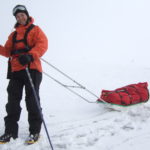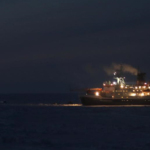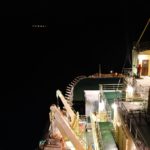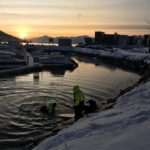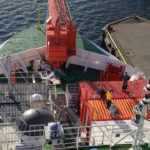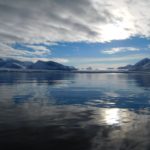Sea salt aerosol (SSA) may influence regional climate directly through scattering of radiation or indirectly via its role as cloud-forming particles. While it is well known that SSA can be cloud condensation nuclei (CCN) forming cloud droplets, it has been shown only recently that SSA can also be a source of ice nucleating particles (INP) forming ice crystals, depending on its chemical composition and surface shape. Arctic clouds are poorly represented in climate models, which is partly due to a lack of understanding of source and nucleating capability of natural aerosol in the high Arctic. Aerosol models for example do currently not capture aerosol maxima in the Arctic winter/spring observed at high latitudes.
Recent field campaigns provide first evidence of a hypothesized source of SSA from salty blowing snow above sea ice. During storms salty snow gets lofted into the air and undergoes sublimation to generate SSA. Additional but minor SSA sea ice sources are frost flowers and open leads. The impact on radiation and clouds of SSA from this new source of SSA above sea ice is not known. However, a quantitative understanding of natural aerosol processes and climate interactions is needed to provide a baseline against which to assess anthropogenic pollution reaching the Arctic and evaluate the success of mitigation measures.
SSAASI-CLIM attempts to determine the SSA source, fate and potential impact on Arctic climate associated with blowing snow above sea ice and other sea ice sources. We do this by participating in the year-long Multidisciplinary drifting Observatory for the Study of Arctic Climate (MOSAiC), which enables us to observe aerosol processes in the central Arctic Ocean throughout all seasons.
Measurements on the sea ice and on-board RV Polarstern include particle size and concentration (sub-micron to snow particle size), INP concentrations, and a range of chemical properties using aerosol filters. Sampling of snow on sea ice, brine, frost flowers will constrain the local source of SSA. Tethered balloon launches will yield information on the fate of particles formed near the sea ice surface as they get lofted to heights where clouds may form.
9 February, 2021 by Amelie Kirchgaessner
British Antarctic Survey scientist Dr Amelié Kirchgaessner shares her journey in polar science for International Day of Women and Girls in Science 2021 (11 Feb). My name is Amelié Kirchgaessner, …
26 February, 2020 by Markus Frey
Dr Markus Frey is on board Russian icebreaker Kapitan Dranitsyn, making the final approach through the Arctic sea ice to join the MOSAiC expedition on board RV Polarstern. German research icebreaker RV Polarstern is staying …
3 February, 2020 by Markus Frey
Dr Markus Frey is on board Russian icebreaker Kapitan Dranitsyn, waiting for a weather window to make the journey north to join the MOSAiC expedition on board RV Polarstern. German …
29 January, 2020 by Markus Frey
Atmosphere and ice climate scientist Dr Markus Frey is on his way to join the MOSAiC (Multidisciplinary drifting Observatory for the Study of Arctic Climate) expedition. Markus will be using …
18 September, 2019 by Markus Frey
The BAS SSAASI-CLIM team arrived in Tromsø a few days ago to set up equipment onboard of RV Polarstern. On Friday 20 Sep 2019 the German ice breaker will embark …
29 August, 2018
UK scientists will join what could be the largest-scale Arctic research expedition ever planned when the German research ship, RV Polarstern, is deliberately lodged into sea ice to drift past …
